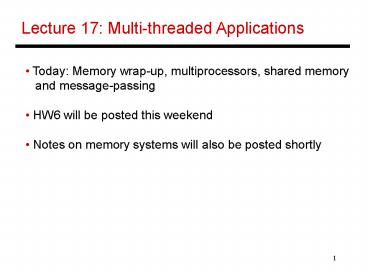Lecture 17: Multi-threaded Applications - PowerPoint PPT Presentation
Title:
Lecture 17: Multi-threaded Applications
Description:
Lecture 17: Multi-threaded Applications Today: Memory wrap-up, multiprocessors, shared memory and message-passing HW6 will be posted this weekend – PowerPoint PPT presentation
Number of Views:63
Avg rating:3.0/5.0
Title: Lecture 17: Multi-threaded Applications
1
Lecture 17 Multi-threaded Applications
- Today Memory wrap-up, multiprocessors, shared
memory - and message-passing
- HW6 will be posted this weekend
- Notes on memory systems will also be posted
shortly
2
Modern Memory System
..
..
..
..
..
..
PROC
- 4 DDR3 channels
- 64-bit data channels
- 800 MHz channels
- 1-2 DIMMs/channel
- 1-4 ranks/channel
..
..
3
Cutting-Edge Systems
..
..
SMB
PROC
..
..
- The link into the processor is narrow and high
frequency - The Scalable Memory Buffer chip is a router
that connects - to multiple DDR3 channels (wide and slow)
- Boosts processor pin bandwidth and memory
capacity - More expensive, high power
4
Future Memory Trends
- Processor pin count is not increasing
- High memory bandwidth requires high pin
frequency - High memory capacity requires narrow channels
per DIMM - 3D stacking can enable high memory capacity and
high - channel frequency (e.g., Micron HMC)
5
Future Memory Cells
- DRAM cell scaling is expected to slow down
- Emerging memory cells are expected to have
better scaling - properties and eventually higher density phase
change - memory (PCM), spin torque transfer (STT-RAM),
etc. - PCM heat and cool a material with elec pulses
the rate of - heat/cool determines if the material is
crystalline/amorphous - amorphous has higher resistance (i.e., no
longer using - capacitive charge to store a bit)
- Advantages non-volatile, high density, faster
than Flash/disk - Disadvantages poor write latency/energy, low
endurance
6
Silicon Photonics
- Game-changing technology that uses light waves
for - communication not mature yet and high cost
likely - No longer relies on pins a few waveguides can
emerge - from a processor
- Each waveguide carries (say) 64 wavelengths of
light - (dense wave division multiplexing DWDM)
- The signal on a wavelength can be modulated at
high - frequency gives very high bandwidth per
waveguide
7
Taxonomy
- SISD single instruction and single data stream
uniprocessor - MISD no commercial multiprocessor imagine data
going - through a pipeline of execution engines
- SIMD vector architectures lower flexibility
- MIMD most multiprocessors today easy to
construct with - off-the-shelf computers, most flexibility
8
Memory Organization - I
- Centralized shared-memory multiprocessor or
- Symmetric shared-memory multiprocessor (SMP)
- Multiple processors connected to a single
centralized - memory since all processors see the same
memory - organization ? uniform memory access (UMA)
- Shared-memory because all processors can access
the - entire memory address space
- Can centralized memory emerge as a bandwidth
- bottleneck? not if you have large caches and
employ - fewer than a dozen processors
9
SMPs or Centralized Shared-Memory
Processor
Processor
Processor
Processor
Caches
Caches
Caches
Caches
Main Memory
I/O System
10
Memory Organization - II
- For higher scalability, memory is distributed
among - processors ? distributed memory multiprocessors
- If one processor can directly address the memory
local - to another processor, the address space is
shared ? - distributed shared-memory (DSM) multiprocessor
- If memories are strictly local, we need messages
to - communicate data ? cluster of computers or
multicomputers - Non-uniform memory architecture (NUMA) since
local - memory has lower latency than remote memory
11
Distributed Memory Multiprocessors
Processor Caches
Processor Caches
Processor Caches
Processor Caches
Memory
I/O
Memory
I/O
Memory
I/O
Memory
I/O
Interconnection network
12
Shared-Memory Vs. Message-Passing
- Shared-memory
- Well-understood programming model
- Communication is implicit and hardware handles
protection - Hardware-controlled caching
- Message-passing
- No cache coherence ? simpler hardware
- Explicit communication ? easier for the
programmer to - restructure code
- Sender can initiate data transfer
13
Ocean Kernel
Procedure Solve(A) begin diff done 0
while (!done) do diff 0 for i ? 1
to n do for j ? 1 to n do
temp Ai,j Ai,j ? 0.2 (Ai,j
neighbors) diff abs(Ai,j
temp) end for end for if
(diff lt TOL) then done 1 end while end
procedure
14
Shared Address Space Model
procedure Solve(A) int i, j, pid, done0
float temp, mydiff0 int mymin 1 (pid
n/procs) int mymax mymin n/nprocs -1
while (!done) do mydiff diff 0
BARRIER(bar1,nprocs) for i ? mymin to
mymax for j ? 1 to n do
endfor endfor
LOCK(diff_lock) diff mydiff
UNLOCK(diff_lock) BARRIER (bar1,
nprocs) if (diff lt TOL) then done 1
BARRIER (bar1, nprocs) endwhile
int n, nprocs float A, diff LOCKDEC(diff_loc
k) BARDEC(bar1) main() begin read(n)
read(nprocs) A ? G_MALLOC() initialize
(A) CREATE (nprocs,Solve,A) WAIT_FOR_END
(nprocs) end main
15
Message Passing Model
main() read(n) read(nprocs) CREATE
(nprocs-1, Solve) Solve() WAIT_FOR_END
(nprocs-1) procedure Solve() int i, j, pid,
nn n/nprocs, done0 float temp, tempdiff,
mydiff 0 myA ? malloc()
initialize(myA) while (!done) do
mydiff 0 if (pid ! 0)
SEND(myA1,0, n, pid-1, ROW) if (pid !
nprocs-1) SEND(myAnn,0, n, pid1,
ROW) if (pid ! 0)
RECEIVE(myA0,0, n, pid-1, ROW) if (pid
! nprocs-1) RECEIVE(myAnn1,0, n,
pid1, ROW)
for i ? 1 to nn do for j ? 1 to
n do endfor
endfor if (pid ! 0) SEND(mydiff,
1, 0, DIFF) RECEIVE(done, 1, 0, DONE)
else for i ? 1 to nprocs-1 do
RECEIVE(tempdiff, 1, , DIFF)
mydiff tempdiff endfor if
(mydiff lt TOL) done 1 for i ? 1 to
nprocs-1 do SEND(done, 1, I, DONE)
endfor endif endwhile
16
Title
- Bullet

